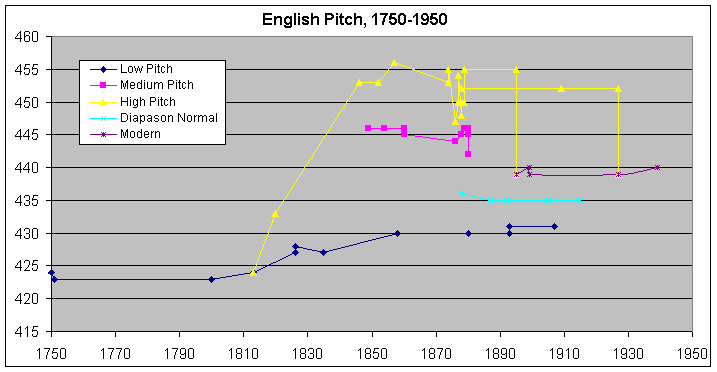Introduction
In trying to work out the mysteries of flute pitch and intonation in
the 19th century, it's useful to have an idea how other instruments in
the era were tuned. In this page, we'll look at those historical
references that are available and add more as they come to notice.
If you are aware of useful references we haven't included, don't
hesitate to let us know.
We'll also try to draw inferences from this raw data. Now,
you'll understand that this is a risky business, so again, if you can
see an alternative interpretation, don't keep it to yourself.
The raw data
The historical information comes from these sources so far:
- "On the History of Musical Pitch", Alexander John Ellis
1880
- "Tuning", Owen H. Jorgensen, Michigan State UP, 1991
- "History of Standard Pitch", Grove's Dictionary of
Music, etc.
- "A History of Performing Pitch : The Story of A", Bruce Haynes
Information tends to be about the tuning of keyboard instruments
(mostly piano) and pitch of orchestras. The pitch of tuning forks
is a common source. Only data relating to England has been
included.
Even with these few sources there are overlaps and confusions.
Hopefully these will be clarified and the gaps filled with the addition
of further sources.
Presentation Approach
Just providing the lists of reference points gives a rather skewed
picture, as a lot of data about some points in time unfairly outweighs
the small amount of data available from others. So a graphical
approach was chosen to provide a linear timeframe. But even
graphing the pitches against their period produced a rather meaningless
jumble of data points, so an attempt to relegate them into series has
been made. This is perhaps the riskiest part of the endeavour, and
revision may be required by more data becoming available.
In any case, the raw data is also provided, enabling you to draw (and
hopefully communicate!) your own conclusions.
Note that where a pitch was noted as being in use for a period of
time, I've indicated that by two entries - one at the start and one at
the end of the period.
The Series
Inspecting the data suggested these series:
- Low Pitch References (432Hz and below)
- Diapason Normal Pitches (circa 435Hz)
- Medium Pitch References (436-446 Hz)
- High Pitch References (447Hz and above)
- Modern Pitch References (circa 440Hz, post 1895)
Graphed against a linear timeframe, this picture emerges:

Observations
Low Pitch References
It seems likely that the century started with low pitch only, set
around 420-425 Hz. This rose slowly to around 430Hz mid century
and persevered into the 20th century as Philosophical pitch - the notion
that it had a particular significance in relation to nature.
The perceived connection to nature is an amusing one. A=430Hz
is the equivalent of C=256Hz. 256 is 2 raised to the power of 8 -
i.e. C 256 is 8 octaves above C1 - an inaudible note whose frequency
would be 1 cycle per second. So? Because the second is a
whole number subdivision of the day (60 x 60 x 24 = 86400), music at
that pitch is seen as being in tune with the rotation of the earth.
Handy.
It is important to note that, from the evidence gathered, low pitch
wasn't actually replaced by High Pitch, contrary to popular opinion.
It appears to have remained as the domestic standard until presumably
taken over by modern pitch. Interestingly a
movement continues to the present to reinstate 430Hz, or more
accurately C 256.
High Pitch References
High pitch seems to have been the preserve of the Philharmonic
Orchestra movement and subsequently military bands. Our earliest
clear reference seems to be a London Philharmonic concert in 1846.
Despite a number of attempts to rein it in, it continued until 1895,
when, according to conductor Sir Henry Wood, a throat specialist Dr
George Cathcart financed the series of Promenade concerts on the
condition they be conducted at Diapason Normal (435). It seems a
compromise of 439Hz (the predecessor to modern pitch) was actually
adopted.
The data point at 433Hz, 1820 has been included in the High Pitch
series as a possible departure point for this pitch. Hopefully,
further data might fill in the gaps between 1820 - 1846. Military
bands battled on at 452 until 1927 when an amendment to the Kings
Regulations adopted 439Hz.
Medium Pitch References
It seems from the wording of the references that as soon as High Pitch was in place, there was a perceived need for an
intermediate pitch. The existence of this medium pitch is not well
known, but is firmly attested by the references. The most
useful information so far is the
report of a meeting held by
the Society of Arts to see what could be done about reducing high
pitch to something more sensible.
Diapason Normal References
This is a perhaps contentious grouping. Diapason Normal was the
reigning pitch in France at the time and thus had no legitimacy in
Britain. Some of the references are specific however, and some
simply fit in well with the pitch and have no other apparent allegiances.
Some evidence to suggest that 435 was in use in England is given by a
boxed set of three tuning forks by J. & J. GODDARD that recently
came up on Ebay. The pitches of the three forks translate to A435, 439 and 454Hz. As the High Pitch
(454Hz) fork is marked Old Philharmonic, we can assume they are
from around the end of the century.
|